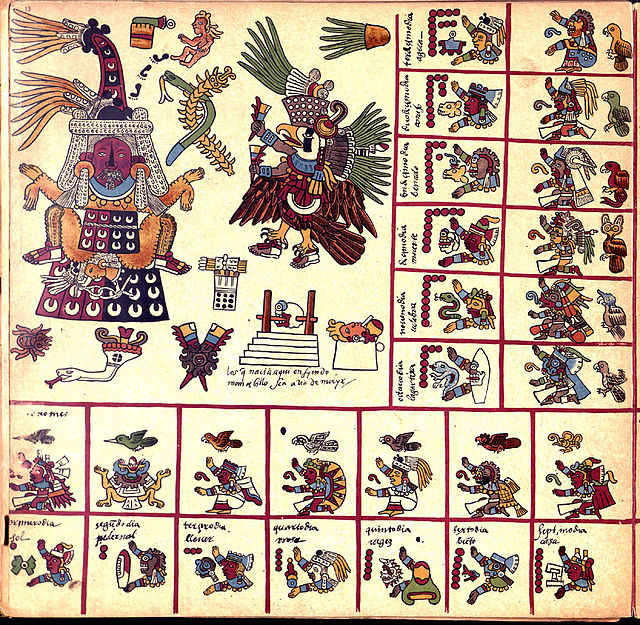Loading AI tools
Aztec deity From Wikipedia, the free encyclopedia
In Aztec mythology, Tlahzōlteōtl (or Classical Nahuatl: Tlâçolteotl, pronounced [t͡ɬaʔs̻oːɬˈteoːt͡ɬ]) is a deity of sexuality, vice, purification, steam baths, lust, filth, and a patroness of adulterers. She is known by three names, Tlahēlcuāni ("she who eats tlahēlli or filthy excrescence [sin]") and Tlazōlmiquiztli ("the death caused by lust"), and Ixcuina or Ixcuinan (Huastec: Ix Cuinim, Deity of Cotton), the latter of which refers to a quadripartite association of four sister deities.[2][3][4]
| Tlahzōlteōtl | |
|---|---|
Goddess of sex | |
| Member of the Nauhtzonteteo | |
 Tlahzōlteōtl as depicted in the Codex Borgia | |
| Other names | Tlahēlcuāni, Tlahzōlmiquiztli, Īxcuinān |
| Abode | Tlalticpac |
| Gender | Female |
| Region | Mesoamerica |
| Ethnic group | Aztec (Nahoa) |
| Genealogy | |
| Parents | Omecihuatl (Emerged by Tecpatl) |
| Siblings | the Nauhtzonteteo (1,600 gods) |
| Children | With Piltzintecuhtli: Cinteotl (Codex Florentine) |

Tlazōlteōtl is the deity for the 13th trecena of the sacred 260-day calendar Tōnalpōhualli, the one beginning with the day Ce Ōllin, or First Movement. She is associated with the day sign of the jaguar.[5]
Tlazolteotl played an important role in the confession of wrongdoing through her priests.[6]
There was a Huastec mother goddess[7] from the Gulf Coast[8] who was assimilated into Aztec views of Tlazolteotl.[7]
Under the name of Ixcuinan she was thought to be quadrupartite, composed of four sisters of different ages known by the names Tiyacapan (the first born), Tēicuih (the younger sister, also Tēiuc), Tlahco (the middle sister, also Tlahcoyēhua) and Xōcotzin (the youngest sister). When conceived of as four individual deities, they were called ixcuinammeh or tlazōltēteoh;[3][4] individually, they were deities of luxury.[9]
According to Aztec belief, it was Tlazolteotl who inspired vicious desires and who likewise forgave and cleaned away sin.[10] She was also thought to cause disease, especially STDs. It was said that Tlazolteotl and her companions would afflict people with disease if they indulged themselves in forbidden love.[11] The uncleanliness was considered both on a physical and moral level and could be cured by steam bath, a rite of purification, or calling upon the Tlazōltēteoh, the deities of love and desires.[11]
For the Aztecs there were two main deities thought to preside over purification: Tezcatlipoca, because he was thought to be invisible and omnipresent, therefore seeing everything; and Tlazolteotl, the deity of lechery and unlawful love.[10] It is said that when a man confessed before Tlazolteotl everything was revealed. Purification with Tlazolteotl would be done through a priest. One could only receive the "mercy" once in their life which is why the practice was most common among the elderly.[12]
The priest (tlapouhqui) would be consulted by the penitent and would consult the 260-day ritual calendar (tonalpohualli) to determine the best day and time for the purification to take place. On the day of, he would listen to the sins confessed and then render judgment and penance, ranging from fasts to presentation of offerings and ritual song and dance, depending on the nature and the severity of the sin.[13]
Tlazōlteōtl was called "Deity of Dirt" (Tlazōlteōtl) and "Eater of Ordure" (Tlahēlcuāni, 'she who eats dirt [sin]') with her dual nature of deity of dirt and also of purification. Sins were symbolized by dirt. Her dirt-eating symbolized the ingestion of the sin and in doing so purified it.[14][15] She was depicted with ochre-colored symbols of divine excrement around her mouth and nose.[15] In the Aztec language the word for sacred, tzin, comes from tzintli, the buttocks, and religious rituals include offerings of "liquid gold" (urine) and gold (Nahuatl teocuitlatl "divine excrement", which Klein jocularly translated to English as "holy shit").[15][16] Through this process, she helped create harmony in communities.[15]
Tlazōlteōtl was one of the primary Aztec deities celebrated in the festival of Ochpaniztli (meaning "sweeping") that was held September 2–21 to recognize the harvest season. The ceremonies conducted during this timeframe included ritual cleaning, sweeping, and repairing, as well as the casting of corn seed, dances, and military ceremonies.[17]
In the film Raiders of the Lost Ark, the fictitious artifact, the Golden Idol is based on the actual Aztec Dumbarton Oaks birthing figure. The artifact is presumed to depict Tlazolteotl.[18]
Seamless Wikipedia browsing. On steroids.
Every time you click a link to Wikipedia, Wiktionary or Wikiquote in your browser's search results, it will show the modern Wikiwand interface.
Wikiwand extension is a five stars, simple, with minimum permission required to keep your browsing private, safe and transparent.